Spatial Analysis of Soil Cover by Definition of Soil Stability Indicators for Flushing in the Upper Shirvan Zone of Azerbaijan
RAE Z H Aliyev*
Institute of Erosion and Irrigation NAS of Azerbaijan, Baku
Submission: January 04, 2018; Published: January 11, 2017
*Corresponding author: RAE ZH Aliyev, Institute of Erosion and Irrigation NAS of Azerbaijan, Baku, Azerbaijan, Email: zakirakademik@mail.ru
How to cite this article: RAE Z H A. Spatial Analysis of Soil Cover by Definition of Soil Stability Indicators for Flushing in the Upper Shirvan Zone of Azerbaijan. Glob J Oto 2018; 12(5): 555850.DOI:10.19080/GJO.2018.12.555850
Abstract
The results of the research prove that the "soil layer” created in the database contains information on the types of soils, as well as their groups in the southern slopes of the foothills of Azerbaijan. Given the availability of cartographic materials, an analysis was also carried out for the Akhsu district as a research facility. The results are given in Tables 1 & 2, which provide information on the area of specific types of soils according to altitude intervals and grades of terrain slopes.
Keywords: Light; Brown, meadow-gray; Hazard; Flushing; Carbonate; Mountain-forest; Unstable; Gray-meadow, etc
Introduction
In Aksuinsky district the largest area is occupied by bright meadow-gray soils-more than 26% of the total area. Significant area is occupied also by meadow-gray soils-12% and gray- brown-almost 11%.Analyzing the distribution of soils along altitude intervals, it is established that at light up to 300 m above sea level, light meadow gray soils occupy 26% of the area, meadow-gray-12.3%, and gray-brown and light gray-meadow soils - 10 %.At an altitude of 300-600 m, mountain gray-brown soils occupy 4%, at an altitude of 600-900 m - washed mountain- brown almost 7% of the total area (Table 1). Depending on the humus content of the soil and its mineral composition, the soil stability index for flushing was calculated, which was subsequently used to determine the degree of erosion threat [1-14].
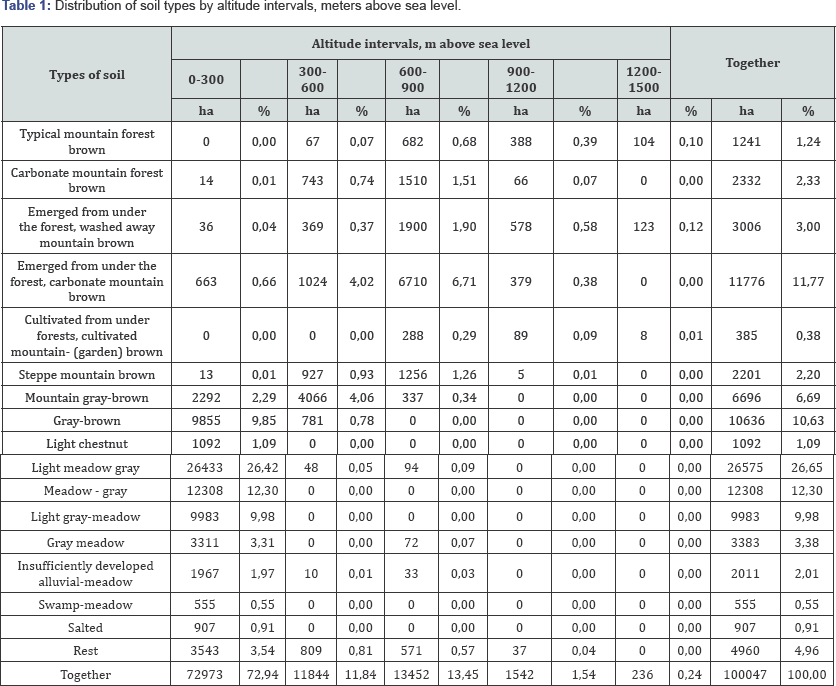
This indicator includes five degrees, where the 1-st stands for soils that are resistant to flushing, and the 5th is very weakly resistant. Based on the analysis of the data in the Akhsu region, it was found that the largest area is occupied by the soils resistant to flushing (1 degree of danger) -58% of the area as a whole. Very unstable to wash away the soil in the region is only 1.6%. The largest area of soils resistant to flushing (1 degree) is in the altitude range from 0 to 300 m. on slopes with a slope of 0-6%. Soils are 2 degrees of stability, i.e. well resistant to flushing, concentrated at an altitude of 300-800 m. with an incline of 10-18%. A significant area of land belonging to this degree of stability is also at an altitude of 100-200 maslong, with a slope of 0-6%. Most of the medium-resistant soils (grade 3) are in the altitude range of 100-300 m. with a slope of the terrain of 0-6% (Tables 2-7).
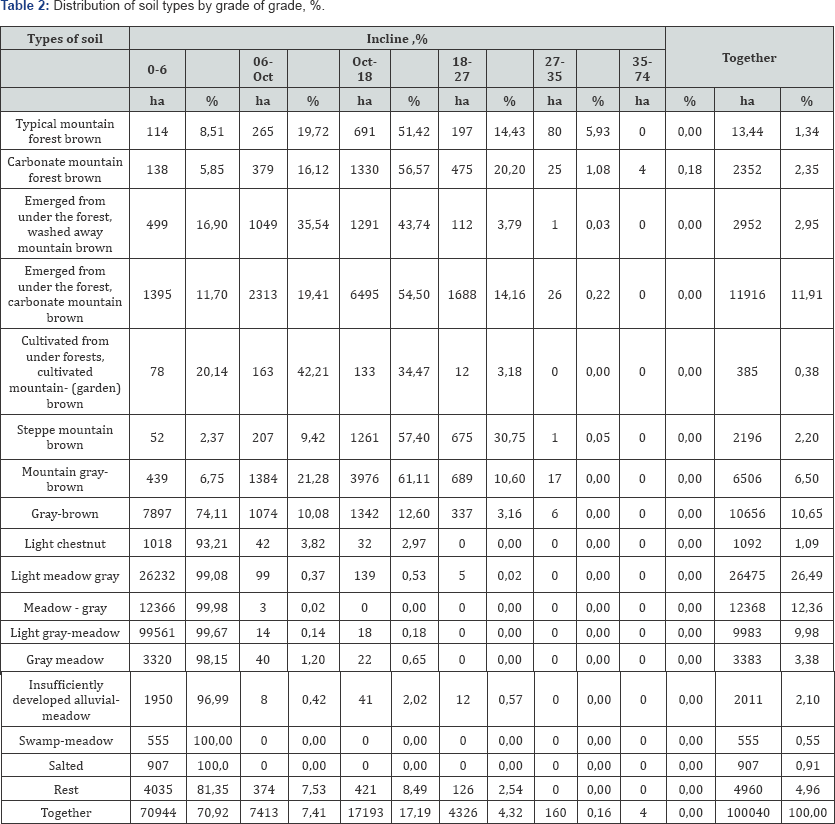

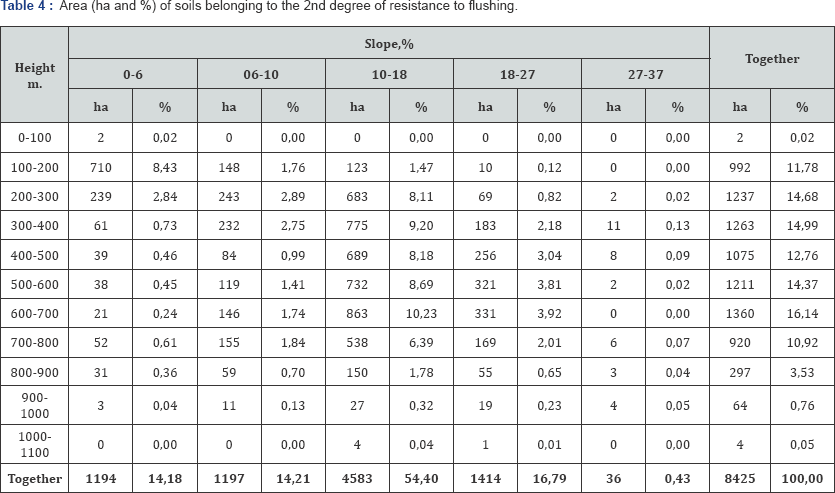
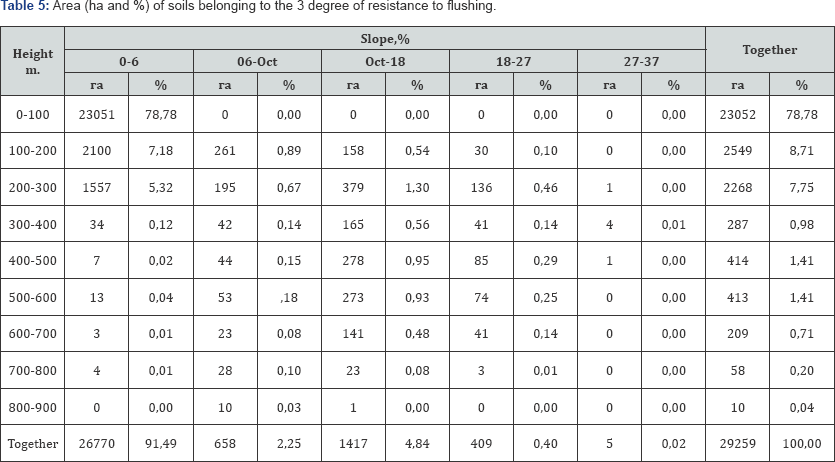
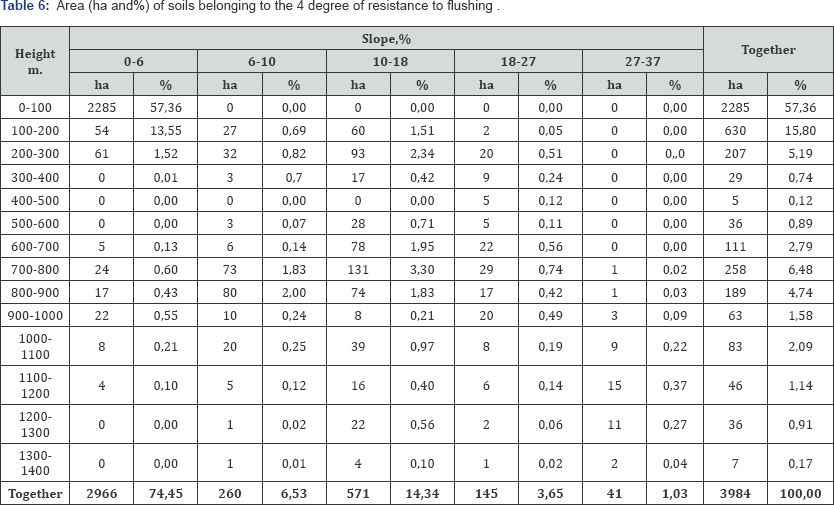

Weakly resistant soils to flushing (4th degree) occupy almost 71% of the area in the altitude range from 100 to 200 m. with a slope of 0-6%. Most of the soils are very unstable to flushing (grade 5) - more than 69%, are located on slopes with a slight slope of 0-6% and a height of 100 to 700 m.
References
- Raigrodski A (2008) Managing the Challenge of Crowning the Single Central Maxillary Incisor. Journal of Esthetic and Restorative Dentistry 20(5): 337-342.
- Pallav Mahesh Patni, Pradeep Jain, Mona Jain Patni (2016) A Conservative Approach to the Management of a Dental Trauma for Immediate Natural Esthetics. Arch Trauma Res 5(2): e29042.
- V Seguela, A Soenen, O Laviole, M Bartala (2011) Reconstitution corono-radiculaire et systemes tout ceramique. Les cahiers de protheses 155.
- Mizrahi B (2008) Restoration of A Single Central Incisor With An All- Ceramic Crown: A Case Report. International Dentistry 10(3): 32-38.
- Probster B, Reiss K, Wiedhahn M, Kern M, Helfer, et al. (2013) Material of the Future, Prosthetic Strategy 13: 1.
- F Spear, MJ Holloway (2008) Which all-ceramic system is optimal for anterior esthetics? J Am Dent Assoc 139(19): S-24S.
- Sunit Kr Jurel, Raghuwardayal singh. All ceramic crown_ an enhanced esthetics. Indian Journal of Dental Sciences.
- Francisco Lia Mondelli, R Caroll Casas Apayco, L Carolina Trentino, A Wang, L Kiyoshi Ishikiriama (2012) Challenges of restoring an anterior maxillary tooth: The impact of fluorescence and the mock-up approach. Quintessence International 43(10).
- Tirlet G, CM, L.C, JPA (2009) All-ceramic crowns: preparations; dental information; 31 -16.
- Zuppardi M, (2016) Easy steps for single central restoration Australasian. Dental Practice Janu 19-8.
- S Kahng (2006) Material selection and shade matching for a single central incisor; The Journal of Cosmetic Dentistry Spring 22: 1.
- Sung Bin Im, Aram Torosian, Alvaro Blasi, Jimmy Londono, Remi Elkattah, et al. (2017) The Challenge of Shade Matching How to Achieve more Predictable Outcomes with All-Ceramic Restorations. Journal of Cosmetic Dentistry Spring 33: 1.
- Mehta R, Kumar A, Goel M, Kumar V, Arora T, et al. (2014) Shade Selection: Blending of Conventional and Digital Methods - An Updated Review Journal of Oral Health review. article Community Dentistry 8(2): 109-112
- Luis Henrique Schlichting, Kyle Stanley, Michel Magne, Pascal Magne (2016) The non-vital discolored central incisor dilemma . The International Journal of Esthetic Dentistry 10-14.
- Mauro Fradeani (2007) Rehabilitation esthetique en prothese fixee: analyse esthetique, Volume 1, Quintescence International.
- Tsurumachi T, Matsumoto S, Kobayashi Y, Ohara K, Suzuki y, et al. (2012) Esthetic and endodontic management of a deep crown-root fracture of a maxillary central incisor. Journal of oral science 54(4): 359-362.
- Bradley J 0lson,(2012) Restoration of a Fractured. Central Incisor Compendium 33-43.
- Tamotsu Tsurumachi, Sakurako Matsumoto, Yoshimi Kobayashi, Kinuyo Ohara, Yusuke Suzuki, et al. (2012) Esthetic and endodontic management of a deep crown-root fracture of a maxillary central incisor. Journal of Oral Science 54(4): 359-362.
- Heffernan MJ, Aquilino SA, Diaz-Arnold AM, Haselton DR, Stanford CM, et al. (2002) Relative translucency of six all-ceramic systems. Part II: core and veneer materials. The journal of prosthetic dentistry 88(1): 10-15.
- Daouahi N, Hadyaoui D, Saafi J (2015) International Journal of Oral Health Dentistry 1(1): 6-10.
- (1998) Anterior esthetic rehabilitation of all-ceramic crowns: a case report. Esthetic dentistry 29: 1.
- Nixon RL (2003) Cosmetic Dentistry-Dentistry's Aesthetic Mt Everest Undetectable Restoration of a Single Discolored Maxillary Central Incisor. Oral Health 93(4): 100-106.





























